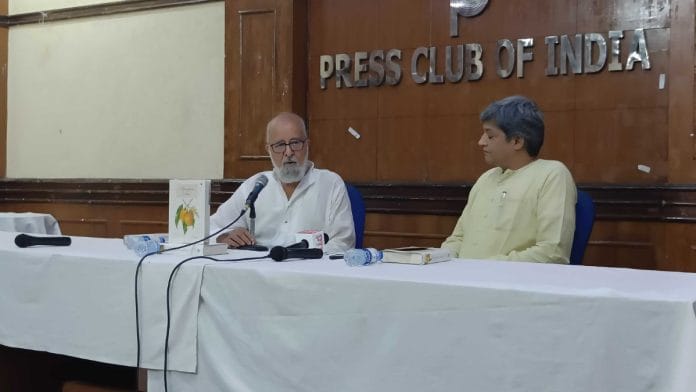New Delhi: Pakistani President Zia-ul-Haq once sent a basket of Anwar Rataul mangoes to former Indian Prime Minister Indira Gandhi. And Indian newspapers hailed it as one of Pakistan’s most unique mango varieties.
When this news reached Indian mango orchard owners, they made an appointment with the PM, informing her about Rataul mangoes’ Indian roots. The cousin of the man who first sowed the Rataul took a kalam (graft) of this variety to Pakistan.
This and many other fascinating stories about mangoes marked the launch of journalist and writer Sopan Joshi’s book, Mangifera Indica: A Biography of the Mango, at the Press Club of India in New Delhi. The event saw Joshi in conversation with filmmaker and heritage conservationist Sohail Hashmi. And it was packed with eager university students and historians.
Hashmi and Joshi agreed mangoes are an integral part of Indian life and culture.
“I don’t think there is another country which has this kind of relationship with one fruit. The reason we feel compelled to talk about mangoes is not the fruit. It’s because today’s world can’t look at them as beyond a fruit,” said Joshi, who had come dressed in a light-yellow Kurta.
According to Joshi, mango groves are central to Indian culture and economy. They are an integral part of every village and even the infrastructure of some cities.
“Wedding parties used to stay in mango groves. I have relatives who are alive who remember staying in mango groves. Picnics used to happen in mango groves,” he said.
Even a mention of these groves triggers nostalgia, Joshi wrote in the introduction to Mangifera Indica. “People go into raptures, retelling stories of emotional connections,”
So how did he end up dedicating an entire book to the fruit? Hashmi’s question took Joshi into the past, when he visited a mango orchard with the historian as part of a news assignment. The article he wrote caught the attention of Aleph Book Company, which urged him to turn it into a book. “After 1.5 years of hard work, I understood what I had to write.”
Many mango surprises
Joshi’s book contains many minute details about India’s mango varieties. As facts and trivia emerged in the course of the discussion, the audience was left intrigued and surprised at the same time.
The author, who has also written Hindi books such as Jal Thal Mal and Ek Tha Mohan: Mahatma Gandhi ka Jeevan Parichay, said that North India has the least diversity in terms of mango varieties. The greatest genetic diversity exists in the eastern and southern parts of the country.
Comparing the flavours of North and South Indian mangoes, Joshi said that in the South, people don’t like their mangoes very sweet. “So, the best mangoes from Southern India will have a delicate sugar-acid balance.”
The discussion didn’t limit itself to taste and variety, extending to changes in India’s mango economy post-Independence. Joshi didn’t seem too happy about them.
When the Zamindari system was being abolished, people with large land holdings converted agricultural land to orchards, in order to defeat the land-seeding laws.
“A bulk of mango orchards in this country are owned by people who don’t set foot on their land and they don’t have any knowledge about the mangoes,” said the author.
Land and agriculture deserve a fresh look, he stressed. “Mango has to survive. We have to look at the land question. This is my little attempt.”
For him, no other country shares such an interesting relationship with the fruit. And no other country is as mindless about that relationship.
“I think that is true not only of the mango, said Hashmi, interrupting Joshi. “Yes,” replied the author with a humble smile.
Also read: Stop this North-South divide over mangoes. The real match is playing out in Bihar and Bengal
Mango’s connect with gods, rituals, people
The discussion soon veered toward the connection between rituals and mangoes, particularly the fruit’s association with Kamadeva, the Hindu god of love and desire. “Let’s have some fun,” said Joshi to Hashmi, excited to delve into it.
He explained that the Kamadeva festival, which spanned two spring months, was symbolised by the mango flower.
“Many deities old and new are linked to the mango. None more so than Kamadeva, the ancient god of desire and love, of sex and procreation…His targets drop their better judgement, their fears and insecurities…Kamadeva’s fruit is the vector of desire,” reads an extract from his book.
That’s how deeply important the mango is to our life and rituals, Joshi told Hashmi. “It’s the symbol of seduction. It’s the symbol of procreation,” he said, adding that now Kamadeva has just disappeared from spring festivities.
The juicy discussion on mangoes ended with a warning. When an audience member from Bihar’s Mithila urged him to give some more details about the types of mango in Bihar, Joshi said:
“Don’t mess with the people of Bihar and Bengal because they have so many [mango] varieties and so many names,” he said as the room erupted in laughter.
(Edited by Zoya Bhatti)






